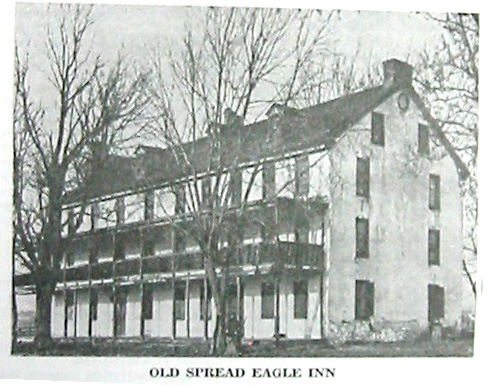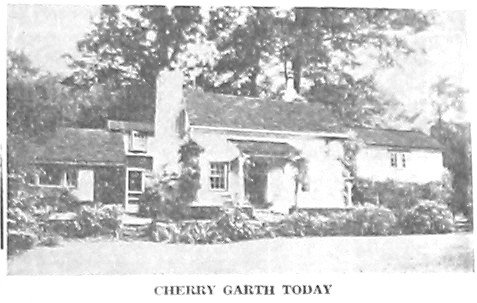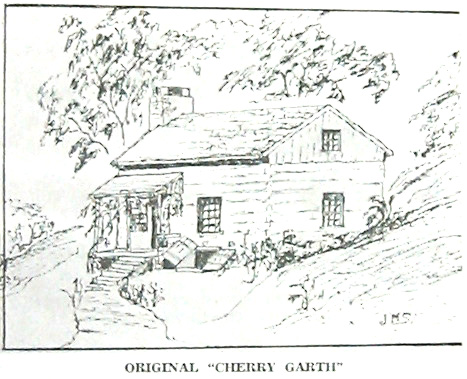After the Lancaster stone turnpike was completed in 1794, the increase of travel along it necessitated the erection of many inns in addition to the early ones such as the Spread Eagle at Strafford. Eventually they averaged about one to the mile, especially as the distance from Philadelphia increased, and there was greater need for meals and overnight accommodations. Space does not permit an enumeration of all of them in this column, although several seemingly accurate lists are still in existence. One more, however, should certainly be added to those we described in last week’s column, since it is a nearby one which is still standing and in good condition, a charming reminder of an era long past. Still known today as the Ship Inn, it is situated on the Lincoln Highway, one mile east of Exton, catering now to the automobile tourist, as in olden days it catered to the stage coach passenger.
This old Inn as it now stands was built in 1796 by one John Bowen, who brought the signboard from an even older Inn which flourished on the Kings’ Highway west of Downingtown in Revolutionary days. The first Inn was operated by a Tory, as were many others of that time. To quote from the interesting little brochure issued by the present proprietor of the Ship Inn, “Several days after the battle of the Brandywine a company of American soldiers stopped at the Inn for refreshment, but the old Tory flew into a rage and ordered them away. To punish him, the soldiers put the ‘Patriots’ curse’ on the Inn by firing thirteen bullets through its sign. The curse was apparently potent, for the original Ship Inn was soon out o*********** f business.” This signboard was later taken to the new location of the “Ship Inn”, where for many years it swung and creaked in its yoke by the roadside.
Quaint assessment records of the year 1794, now in possession of the Chester County Historical Society, list:
1 large ditto (Stone Building not finished) $600.00
1 stone stable, not finished 80.00
1 log barn 40.00
1 stone spring house 50.00
1 frame necessary 1.00
1 cart house on posts (Buckwheat straw roof) .05
From these figures it is not difficult to estimate the modest cost of the Ship Inn which remains to this day such a charming landmark on the old highway.
This tale of the old signboard, into which the soldiers shot thirteen holes, calls to mind stories of two others Inns in the close vicinity of the Spread Eagle. They were told to me by Miss Lecian Von Bernuth, who is well versed in the history of Strafford, where she makes her home. It seems that in Revolutionary days there was another Inn almost opposite the Spread Eagle. Some English soldiers were quartered at the former, while at the latter there were a few from the American army. At various times they are said to have made forays into each other’s premises, sometimes even meeting in the middle of the road for a skirmish.
The little old stone house standing even to this day just to the west of the present Spread Eagle Mansion was once a roadhouse where men from the American forces were stationed. The big oak still standing in the field back of this building is said to have been a lookout towards Valley Forge. Up until a comparatively short time ago the old bar was still in the small building as was the trap door that on occasion plunged undesirable patrons into the basement!
Some of these nearby taverns took the overflow which could not be accommodated in the more desirable quarters of the Spread Eagle. Doubtless, too, they served for the more ribald element whose presence at the Inn was not welcomed. As the reader looks at the lovely Spread Eagle Tavern as pictured in last week’s column it is interesting to reconstruct scenes within and without as described in J. F. Sachse’s book, from which we have quoted liberally already. Mr. Sachse says:
“Within the tavern all would be life and animation. On warm, fair nights the porch as well as the piazza above was illuminated by large reflecting lamps, where on such occasions congregated the ladies and gentlemen who were stopping there either permanently or merely temporarily to while away the time and watch the life and bustle on the road in front of the Inn, as well as in the yard beyond; the shouts and activity of the hostlers and stablemen at the arrival or departure of the mail or post coach, the rapidity with which the horses were unhitched, or replaced by fresh relays after the passengers had refreshed themselves, the numbers of travelers on horseback or in private conveyance, the occasional toot of a stage horn or ringing of the hostlers bell. All tended to form a continuous change of scene.”
As the Inn guests looked over the rail of the cool, shaded second floor porch they might see long lines of Conestoga wagons going either to the East or the West. These wagons were usually drawn by “five stout horses, each horse having on its collar a set of bells consisting of different tones, which made very singular music as the team trudged along at about the rate of four miles an hour” or there might be companies of emigrants traveling together for mutual assistance towards the new West, there to found homes of their own. Large herds of cattle or flocks of geese also added to the panorama.
In 1823 there were eleven principal lines of “Land Stages” running daily East and West on the turnpike past the Spread Eagle. Among them were the quaint names of “Harrisburg Coachee”, “Lancaster Coachee”, “Lancaster Accommodation”, “Harrisburg Stage”, “Lancaster and Pittsburgh Mail” and others. The fare for way passengers was usually six cents a mile. Through fare from Philadelphia to Pittsburgh was $18.50 each way, meals and lodgings extra.
The “Coachee” here mentioned is described as a carriage peculiar to America, with the body rather longer than that of a coach, but of much the same shape. In the front “it was left open down to the bottom, and the driver sat on a bench under the roof of the carriage. There were two seats in it for passengers, who sat with their faces towards the horses. The roof was supported by posts at the corners, on each side of the doors, above the panels; it was open and to guard against bad weather there were curtains made to let down from the roof and fasten to buttons placed for the purpose on the outside. There was also a leather curtain to hang occasionally, between the driver and the passengers. The Coachee had doors at the side, since the panels and body were generally finely finished and varnished”.
All of this picturesque type of travel that continued by night as well as by day, with the attendant hustle and bustle at the wayside inns, reached its height in the late 1820’s. For it was then that the Philadelphia and Columbia Railroad was completed by the Canal Commission. Although many of the more spacious inns such as the Spread Eagle continued in existence for some years afterwards, the necessity for them decreased in ration to the lessening of traffic on the turnpike. Some, however, remained open as summer boarding houses as the Spread Eagle did for a number of years. When the picture reproduced in last week’s Suburban was taken in 1886 by Mr. Sachse, he wrote that “the old inn, though in good repair, is closed and without an occupant, and looms up on the roadside like a dark and sombre relic of the past, with nothing to remind the present generation of its departed glories.”
(To be continued)
(Information on the date of the building of the present Spread Eagle Mansion, as well as names of various owners and any other interesting data will be welcomed by Mrs. Patterson who, to date, has been able to find little of its history. Mrs. Patterson’s address is Windermere Court, Wayne, her telephone is Wayne 4569.)



